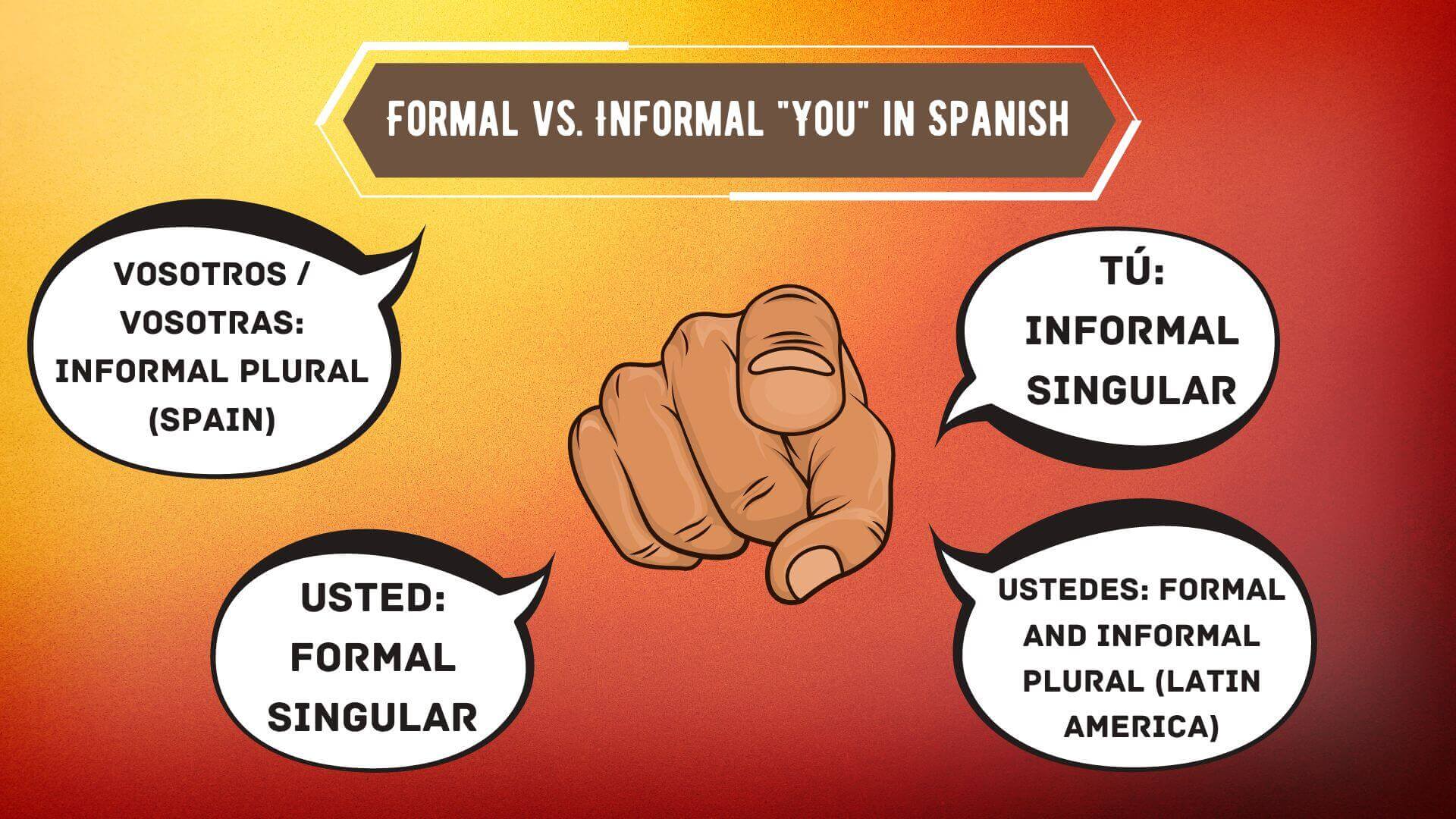In Spanish, how you say ‘you’ really matters. You can use ‘usted’ or ‘tú.’ ‘Usted’ is more formal. It shows respect and is used in professional situations, or when talking to someone older or in charge. On the other hand, ‘tú’ is informal and friendly. It’s what you use with friends, peers, or family. Understanding when to use ‘usted’ and ‘tú’ isn’t just about language. It’s about culture too. It helps you communicate well and fit in. Let’s dive deeper into when and why these differences matter. How do they show what people value and how they relate to each other?
Overview of Personal Pronouns in Spanish
Spanish personal pronouns are essential tools in conversation. They help us tell who’s who, from the speaker to the listener. These pronouns change depending on the number of people you’re talking about, how formal you want to be, and where you are.
In simple terms, when talking to one person, use ‘tú’ for informal chats and ‘usted’ when it needs to be more formal. When addressing a group, it gets a bit different. In Spain, ‘vosotros’ is for casual conversations with friends, while ‘ustedes’ is used in more formal situations. But in Latin America, everyone just uses ‘ustedes,’ no matter the setting.
In some places, you might also hear ‘vos.’ It’s a mix of both formal and informal and can vary a lot depending on where you are. It’s pretty important to get these right, as they can really change the tone of your conversation. It shows that paying attention to the cultural context is just as important as the words you use.
Formal vs. Informal “You” in Spanish

Tú: Informal Singular
‘Tú’ is the go-to informal pronoun in Spanish, used among friends, family, or people you’re close to. It’s common in all Spanish-speaking areas and shows a relaxed, personal connection. When you use ‘tú,’ it’s like saying you’re on the same level as the person you’re talking to. This is usually not the case in formal or professional settings unless both sides agree on it. Also, when you use ‘tú’, the verbs change a bit, using informal endings that are different from the formal ones. If you’re learning Spanish, it’s pretty important to get the hang of when to use ‘tú’ and other pronouns. It really changes how your conversation feels and fits into different social situations.
Usted: Formal Singular
When you talk to someone formally in Spanish culture, it’s common to use ‘usted.’ This form shows respect, especially with authority figures, older people, or when you meet someone for the first time. It’s different from the informal ‘tú’ because it keeps a respectful distance. This affects how you conjugate verbs and the tone of your conversation. ‘Usted’ is known everywhere in Spanish-speaking areas and is crucial for keeping things professional. If you want to get along in Spanish social settings, knowing how to use ‘usted’ right is key.
Vosotros / Vosotras: Informal Plural (Spain)
In Spain, ‘vosotros’ and ‘vosotras’ are informal ways to talk to groups. ‘Vosotros’ is for groups with men, and ‘vosotras’ is for groups of just women. These words help keep things casual, like when you’re chatting with friends, family, or folks your age. In other places where Spanish is spoken, people use ‘ustedes’ for both formal and informal situations. But in Spain, using ‘vosotros’ or ‘vosotras’ keeps things friendly and affects how verbs are used in conversation. It’s a special part of Spanish that you only see in Spain.
Also Read: What Does ‘Hay’ Mean In Spanish? When & How To Use It
Ustedes: Formal and Informal Plural (Latin America)
In Latin America, the word ‘ustedes’ works for both formal and informal group conversations. It’s simple; you use the same word whether you’re at work or with friends. This makes it easy for people to talk in groups without worrying about being too formal or casual. ‘Ustedes’ matches the verb forms used with ‘usted,’ the formal way to say ‘you’ when talking to one person. So, everything stays consistent, no matter the setting. This is different from Spain, where they use ‘vosotros’ or ‘vosotras’ for casual group chats.
Guidelines for Using Formal vs. Informal “You”
When to Use Tú
‘Tú’ is usually used in casual situations with friends, family, or relaxed workplaces. Young people often say ‘tú’ to each other, no matter how well they know one another. In Spanish cultures, using ‘tú’ shows friendliness and warmth. It’s also the normal choice for talking to children and pets, showing a close and caring connection. If you’re learning Spanish, it’s important to know when to switch from ‘tú’ to a more formal word to keep communication clear and respect social rules in different situations.
Also Read: How To Say “Congratulations” In Spanish: Different Wishes For All Occasions
When to Use Usted
Knowing when to use ‘usted’ is key to keeping things formal in Spanish conversations. You use ‘usted’ to show respect. It’s for talking to people in charge, those older than you, or someone you don’t know well. You’ll find it used a lot in formal situations like business meetings, events, or when dealing with clients. It’s also common in schools, where students use it to address teachers or professors.
Regional Variations and Preferences
In Spanish, how you say ‘you’ can vary a lot depending on the place. For example, in Argentina and Uruguay, people mostly use ‘vos’ for both casual and formal chats. This is different from the usual ‘tú’ and sometimes even ‘usted’.
However, in Central America, ‘usted’ is strictly for formal situations, keeping it distinct from the more casual ‘tú’. Over in Spain, ‘ustedes’ is for formal group talks, while ‘vosotros’ is used among friends or in informal group settings. Knowing these local preferences really helps in communicating respectfully and effectively in Spanish-speaking areas.
Conclusion
It’s simple: using ‘tú’, ‘usted’, ‘vosotros’, ‘vos’, and ‘ustedes’ correctly helps you communicate well and show respect. Each pronoun changes how you conjugate verbs and sets the tone of your conversation. Get it wrong, and you might confuse someone or seem rude. Whether you’re talking casually with friends or formally at work, knowing which ‘you’ to use is crucial. Plus, understanding these differences in various Spanish-speaking places makes you a better speaker and more culturally aware. Keep visiting the Translation Blog for more translation articles like this.

